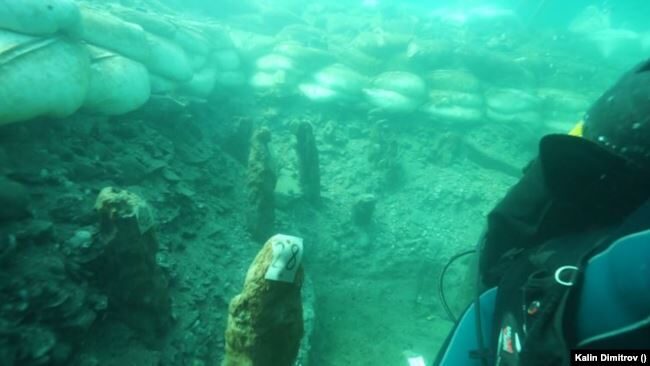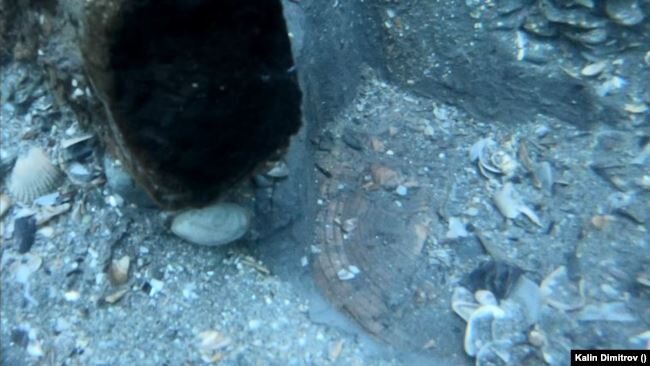
Archaeological traces from the submerged prehistoric settlement on the Black Sea coast, near the mouth of the Ropotamo River in Burgas District in Southeast Bulgaria were first stumbled upon in the 1970s.
In 2017-2019, an international archaeological team from the Black Sea MAP project discovered the submerged prehistoric settlement off the coast at the mouth of the Ropotamo River, and judged it to be from the Early Bronze Age.

Thus, the research of the Center for Underwater Archaeology based in Bulgaria's Black Sea town of Sozopol has pushed back its dating to the Chalcolithic (Aeneolithic, Copper Age), ca. 4,000 BC, and it is 6,000 years old.
"Our discovery from this year are materials from the Copper Age from the settlement which at the time of its existence was situated entirely on land - since they have been found in a layer which is characteristic of the land environment," archaeologist Kalin Dimitrov from the Sozopol Center for Underwater Archaeology has told the Bulgarian edition of Radio Free Europe.
Archaeological research so far indicates that the submerged prehistoric settlement near the mouth of the Ropotamo River in Southeast Bulgaria was continuously inhabited.
After its settling in the Chalcolithic 6,000 years ago, as it turns, it was also inhabited during the Bronze Age. And in the 6th century AD, the Iron Age, the period of Ancient Thrace and of the Ancient Greek colonies on today's Bulgarian Black Sea coast, the site had a sea port.
In 2017, as part of the Black Sea MAP project, which has produced a number of sensational discoveries from the sunken ships in Bulgaria's Black Sea zone, the research of the prehistoric settlement at the mouth of the Ropotamo River was restarted due to the fact that the site is very well preserved, and has not been damaged by construction.
"Back then, our research between 2018 and 2020 showed that below the layer of the port there are Bronze Age settlement remains, dating back to the transition between the 4th and the 3rd millennium BC, from the very beginning of the Bronze Age on the Bulgarian [Black Sea] coast," explains Dimitrov who has been the lead archaeologist in the research effort.
The underwater expedition in September 2020, however, have demonstrated that the settlement goes back to ca. 4,000 years BC, and that at the time it was entirely on land.
The newly discovered Chalcolthic materials show that humans lived in the now submerged prehistoric settlement 6,000 years ago, which is some 1,500 years before the construction of the Cheops Pyramid in Ancient Egypt in the 2,600 - 2,500 BC.
The latest findings from the submerged prehistoric settlement at the mouth of the Ropotamo River, however, also reveal information about climate change and the effect on the rise of the sea level.
The above footage of Radio Free Europe provided by archaeologist Kalin Dimitrov shows the underwater research of the submerged prehistoric settlement near the mouth of the Ropotamo River.
They show that about 5,000 years ago, that is, ca. 3,000 BC, the level of the Black Sea was about 5 meters lower than it is today.
The Bulgarian archaeologists have established that while during the original settling of the site near the mouth of the Ropotamo River in the Chalcolithic, the prehistoric coastal settlement was entirely on land, the level of the Black Sea rose rapidly, and in the subsequently Bronze Age the inhabitants of the place already had to build their homes above the water, on top of wooden stilts, i.e. they had to live in stilt houses.
Parts of the wooden stilts from the prehistoric stilt homes in question have been found surviving under water testifying to the rapid increase of the level of the Black Sea during the said period.
The archaeologists have also found out more about the Antiquity Era port which existed at the mouth of the Ropotamo River in Southeast Bulgaria.
"This port operated over a very long period of time, almost without interruption, from the 5th century BC until the Modern Era," Dimitrov says.
"If one looks at the materials from the various ages, it is very easy to notice the periods of prosperity, development, and wealth of this region, as well as the crisis periods, from which there are almost no materials left," he elaborates.
The Antiquity port in question was the door to the valley of the Ropotamo River, which was a very fertile and rich region at the time.
The researchers believe that the Antiquity port in question was part of the territory controlled by the Ancient Greek colony of Apollonia Pontica, today's Sozopol.
The Ropotamo port thus followed the rises and declines of Apollonia Pontica itself.
The Sozopol-based Center for Underwater Archaeology of the National Institute and Museum of Archaeology in Sofia is set to keep researching the 6,000-year-old submerged prehistoric settlement at the mouth of the Ropotamo River in Southeast Bulgaria.
There Bulgarian underwater archaeologists have information of only one more similar submerged prehistoric settlement, whose remains are located below the Black Sea level, off the coast from the present-day port of Sozopol.
Background Infonotes.
Ivan Dikov, the founder of ArchaeologyinBulgaria.com, is the author ofthe book Ugly Bargain: How the European Union and Bulgaria's Post-Communist Oligarchy Fit Together, among other books.
Please consider donating to us to help us preserve and revive ArchaeologyinBulgaria.com to keep bringing you more and more exciting archaeology and history stories. Learn how to donate here:
Emergency Call for Donations to Save ArchaeologyinBulgaria.com amid the Pandemic Fallout



Comment: See also: